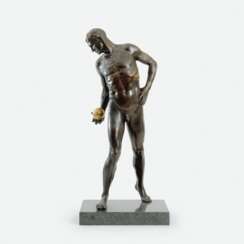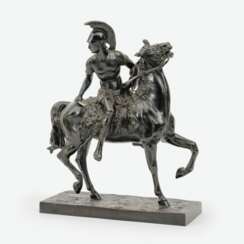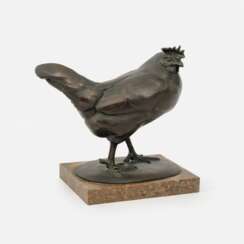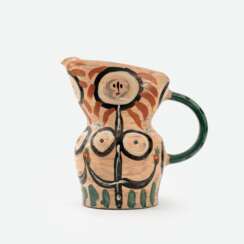
Sculpture and design — Kunst Auktion

Käthe Kollwitz (born as Schmidt) was a German artist who worked with painting, printmaking (including etching, lithography and woodcuts) and sculpture. Her most famous art cycles, including The Weavers and The Peasant War, depict the effects of poverty, hunger and war on the working class. Despite the realism of her early works, her art is now more closely associated with Expressionism. Kollwitz was the first woman not only to be elected to the Prussian Academy of Arts but also to receive honorary professor status.

Adrien Étienne Gaudez was a 19th century French sculptor. He studied sculpture under François Joffroy at the Ecole des Beaux-Arts in Paris.
Adrien Étienne Gaudez is known for his monumental figures cast in bronze.

Robert Eduard Henze was a German sculptor. He studied at the Dresden Academy of Art under Ernst Ritschel and after his death under Johannes Schilling and Ernst Henel.
Robert Eduard Henze created many sculptures, including portraits, allegorical and religious compositions.

André-Joseph Allar was a French sculptor. He studied at the Schools of Fine Arts in Marseille and Paris with Eugène Guillaume, Antoine Laurent Dantan and Pierre-Jules Cavelier.
André-Joseph Allar is best known for his small works and architectural projects.

Ferdinand Liebermann was a German sculptor.
Liebermann studied sculpture at the School of Arts and Crafts and at the Academy in Munich with Heinrich Wadere. After additional studies in Rome and Paris, he opened his studio in Munich in 1910 and was awarded the Grand Austrian State Medal in gold for a small bronze the same year. In 1926 he became professor of monumental and portrait sculpture in Munich.
Ferdinand Liebermann's works include numerous sculptures of buildings, monuments and fountains, and he was also one of the most important figure designers for the Rosenthal manufactory.
Hermann Joachim Heinrich Pagels was a German sculptor. He studied at the Academy of Fine Arts in Berlin from 1894 to 1900.
In 1911, Hermann Joachim Heinrich Pagels designed a porcelain portrait statuette of Prince Wilhelm of Prussia.
During National Socialism, Pagels became famous for his busts of Adolf Hitler and other Nazis.

Rudolf Alexander Agricola was a German sculptor. In the 1930s he studied with Gerhard Marcks in Halle and in Stedel with Richard Scheibe. In 1937 he followed Richard Scheibe to Berlin as a graduate student. He worked there until the end of the Second World War and received several awards.
Rudolf Agricola is known for his bronze sculptures with full figures and nudes. His work was influenced by Georg Kolbe and Aristide Maillol.

Rudolf Kaesbach was a German sculptor.
Rudolf Kaesbach studied at the academies of Hanau (drawing), Paris (foundry) and Brussels. In Düsseldorf he ran a workshop in which he cast his own models.
After 1904, Rudolf Kesbach presented a series of life-size marble figures to the public at exhibitions in Berlin, Düsseldorf and Malmö. Later he devoted himself increasingly to the depiction of nude women. Much of his work took him beyond Art Nouveau to Art Deco.
In 1939, 1940, 1941 and 1943, Kiesbach exhibited his sculptures at the Great German Art Exhibitions in Munich. These exhibitions were representative under National Socialism.
Georg Mattes was a German sculptor. His work can be found in many Munich churches, schools, hospitals and museums.
Georg Mattes was professor of sculpture at the Munich Academy of Arts.

Karl Peter Hugo Siegwart was a Swiss sculptor and medallist. He studied at the Academy of Fine Arts in Munich with Max von Widnmann and in Paris at the Académie Julian with Henri Chapu.
Hugo Siegwart's work extended to monumental sculptures, portrait busts, small sculptures and building reliefs, while striving for the most accurate and realistic reproduction of nature.

Hugo Lederer was a German sculptor and medallist. He lived and worked in Berlin during the reign of Kaiser Wilhelm II and the first German democracy. His most famous work is the monumental monument to Bismarck in Hamburg (1902-1906).
Hugo Lederer always stood on the side of upper-class modernism and opposed the anti-bourgeois left-wing or popular art scene. Initially he was still following Reinhold Begas and his neo-Baroque style, the Gründerzeit art movement favoured by Kaiser Wilhelm II and despised by many intellectuals of the time.

Hans Guradze was a German sculptor and graphic artist with Georgian roots. Hans Guradze often used Russian motives in his bronze sculptures. He also sculpted animals with passion, mainly horses.

Rudolf Kaesbach was a German sculptor.
Rudolf Kaesbach studied at the academies of Hanau (drawing), Paris (foundry) and Brussels. In Düsseldorf he ran a workshop in which he cast his own models.
After 1904, Rudolf Kesbach presented a series of life-size marble figures to the public at exhibitions in Berlin, Düsseldorf and Malmö. Later he devoted himself increasingly to the depiction of nude women. Much of his work took him beyond Art Nouveau to Art Deco.
In 1939, 1940, 1941 and 1943, Kiesbach exhibited his sculptures at the Great German Art Exhibitions in Munich. These exhibitions were representative under National Socialism.

Otto Pilz was a German porcelain sculptor and model maker. He worked for the famous Meissen porcelain factory, for which he created a number of famous sculpture models from 1905 to 1912. He also designed sculptures for Schwarzburger Werkstätten and Hutschenreuther.

Fritz Behn, full name Max Adolf Friedrich Behn, is a German sculptor and graphic artist who became famous primarily for his sculptures of African animals. He studied at the Munich Academy of Fine Arts.
Fritz Behn was a member of the Munich Secession.

Fritz von Graevenitz was a German painter, sculptor and university lecturer. He studied fine art at the Academy of Fine Arts in Stuttgart.
The National Socialists promoted Fritz von Grevenitz as an artist and represented him several times at the Great German Art Fairs in Munich.
Fritz von Grevenitz mainly created monuments, cenotaphs, fountains, portraits and animal figures, most of which are in public places in German cities.



Pablo Ruiz Picasso, a Spanish artist renowned for his revolutionary contributions to the 20th-century art scene, is a figure that resonates profoundly with collectors and art experts. His unique blend of talents in painting, sculpture, printmaking, and ceramic art, infused with his time in France, positioned him as a pivotal character in modern art history.
Picasso's artistic journey was marked by distinct periods, each showcasing his evolving style and genius. His early years were characterized by the Blue Period (1901-1904), followed by the Rose Period (1904-1906), and then the African-influenced Period (1907-1909). Picasso's name is synonymous with Cubism, a movement he co-founded, which significantly altered artistic perspectives and methods. Works like "Les Demoiselles d'Avignon" (1907) and "Guernica" (1937) are emblematic of his cubist legacy, the latter being a poignant anti-war statement that remains influential.
His later years saw a return to more traditional styles, with neoclassical and surrealist influences becoming evident. Works from these phases reflect a deep engagement with mythological themes, as seen in "Faun with Stars" (1955), symbolizing his late-life romance with Jacqueline Roque, his second wife.
Picasso's prolific output and innovative spirit made him a legend in his own time, a status that only grew after his death. His works, housed in major museums and private collections worldwide, continue to captivate and inspire.
As a collector or expert in art and antiques, staying informed about Picasso's works, their auction events, and sales is essential. To stay updated on the latest developments and opportunities related to Pablo Picasso, sign up for our specialized updates. Rest assured, this subscription will focus solely on new product sales and auction events pertaining to Picasso's art, ensuring that you receive only the most relevant and valuable information.

Niki de Saint Phalle was a French-American sculptor, painter, filmmaker, and author of colorful hand-illustrated books. Widely noted as one of the few female monumental sculptors, Saint Phalle was also known for her social commitment and work.


 Макс Клингер. Никола Першайд. Фотографический портрет Макса Клингера, 1913.jpg)



























































